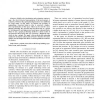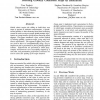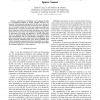149 search results - page 16 / 30 » Mobile robot localization with an incomplete map in non-stat... |
ICRA
2006
IEEE
14 years 1 months ago
2006
IEEE
— Mobile robot localization and navigation requires a map - the robot’s internal representation of the environment. A common problem is that path planning becomes very ineffic...
ROBOCUP
2007
Springer
14 years 1 months ago
2007
Springer
In this article the classical self-localization approach is improved by estimating, independently from the robot’s pose, the robot’s odometric error and the landmarks’ poses....
ICRA
2000
IEEE
13 years 11 months ago
2000
IEEE
Mobile robots require the ability to build their own maps to operate in unknown environments. A fundamental problem is that odometry-based dead reckoning cannot be used to assign ...
RAS
2008
13 years 6 months ago
2008
Task planning for mobile robots usually relies solely on spatial information and on shallow domain knowledge, like labels attached to objects and places. Although spatial informat...
ICRA
2009
IEEE
14 years 2 months ago
2009
IEEE
— Simultaneous localization and mapping (SLAM) is a well-studied problem in mobile robotics. However, the majority of the proposed techniques for SLAM rely on the use of accurate...



